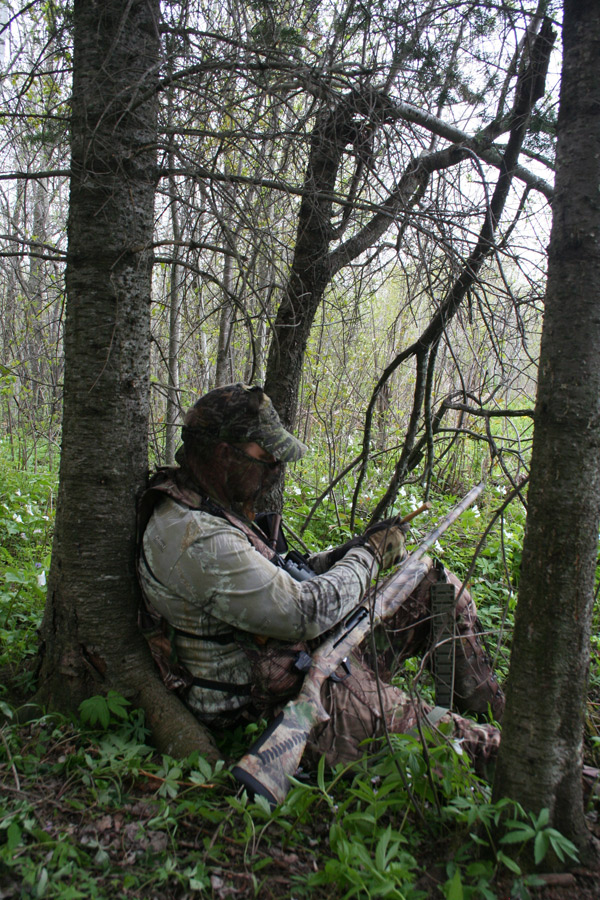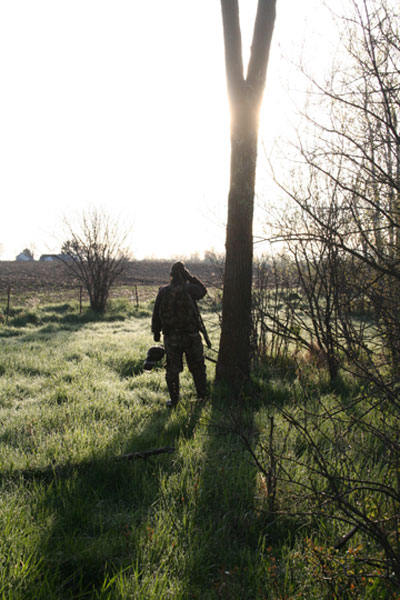“Better Late… Expert turkey caller prefers season 6”
By Dick ELlis
Time was slipping fast on the Wisconsin spring turkey season. Any gobblers rising to the roost at day’s end on this Friday near Barron in northwest Wisconsin would have already survived five, 5-day seasons….25 days…plus the first three sunsets of this final 2011 challenge. “Would have”, though, and survival itself become long-odds when Neal Herrman waits with his arsenal of calls, cradling a Benelli scattergun meticulously sighted in for longbeards to 60 yards. Most often, the spring season carries hunters from the unpredictable weather of a Wisconsin April, to the warm May days of mosquitoes and ticks. Usually, as time runs out on season 6, full foliage offers the hunter cover and a chance to move toward any gobbler willing to betray his position with a verbal invitation to any hens still willing. It’s that lonely posture with most hens already on the nest that now makes Tom vulnerable. Although a favorite to few hunters, Season 6 is Herrman time.
Most often, the spring season carries hunters from the unpredictable weather of a Wisconsin April, to the warm May days of mosquitoes and ticks. Usually, as time runs out on season 6, full foliage offers the hunter cover and a chance to move toward any gobbler willing to betray his position with a verbal invitation to any hens still willing. It’s that lonely posture with most hens already on the nest that now makes Tom vulnerable. Although a favorite to few hunters, Season 6 is Herrman time.
“It’s the best chance to kill a boss gobbler,” said Herrman, who has won or placed in numerous calling contests in Wisconsin and throughout the Midwest. “He’s lonely. There aren’t many hens and the bachelor groups have not yet formed. They can be very responsive to calls. The biggest gobblers I ever tagged were taken in season five or six including a 26 pound Tom at the end of May that would have been two or three pounds heavier when the season started. A gobbler is like a rutting buck. They don’t eat; all they’re doing is strutting, breeding and chasing other gobblers off. I also tagged a couple over 25 pounds.”
In 2011, the cold spring has changed the game on the 300 family owned acres of lightly rolling hardwoods surrounded by tamarack swamp and 120 acres of tilled fields. Tree buds are just opening, and the hunter can see the full moon rising through 100 yards of open woods. Under normal conditions he might see just 10 or 20 yards. There are hunter’s risks in Mother Nature procrastination. Tom’s extraordinary vision is nature’s most valuable gift in keeping him alive. The hunter can move toward a bird he knows is out there, but it’s with a “hold your breath” tenseness that only eases when he settles in at the base of the next tree trunk to try the call again.
Herrman sits alone and contemplates his move. The reporter that shadowed him all of Wednesday with a camera is gone. The hunter had passed on two jakes Wednesday that had come in quickly to his calls. By late afternoon, a big gobbler was literally five yards from the kill after a two hour verbal duel when a real boss hen had appeared on the opposite side of the field to pull Tom away. Thursday had proved uneventful.
He knows Tom is near and lonely. Since Herrman’s imitation of a hen’s fly-down cackle, Tom has answered the hunter’s clucks, purrs, cutting and yelps with “thundering” gobbles. But he’s “hung-up” now, and apparently unwilling to move from his secure spot on the edge of a swamp bordering the hardwoods. Herrman reaches again for a bloodwood and black walnut double-sided short-box. Instead of a hen call, he aggressively manipulates the cover over the wood to precisely duplicate a challenging gobble. Soon, he watches for the first time as the bobbing red head of Tom rises toward him with the fog from the swamp…
Herrman’s own rise in the world of turkey hunting has been meteoric, reflecting his passion for the sport. From a family interested only in deer hunting, he hunted turkeys initially in 2000 with a push button call and a near empty bag of knowledge. By the time he had killed his first gobbler in 2001, his calling was impressive enough that he was asked to judge the National Wild Turkey Federation (NWTF) state chapter calling competition. “They thought I could run (imitate calls) a call pretty good, he said. “Looking back I was miserable at it.”
By 2002, he was successfully turkey hunting in the UP of Michigan, followed during ensuing seasons season with more success in out-of-state hunts to Nebraska, Kansas, and South Dakota targeting the four sub-species of wild turkey. In 2008, he completed the coveted Grand Slam in Florida by tagging the Osceola, having previously bagged Eastern (Wisconsin turkey), Rio Grande and Merriam subspecies.
“Each turkey has traits that make it difficult to hunt,” he said. “The Eastern turkey is tight-lipped during the day. The Merriam is the opposite. He’ll talk all day but travel three miles. I’ve called them in from three-quarters of a mile. You hardly see them; they’re a speck on the horizon. I’m very fortunate. I’ve been in the right place at the right time.”
Enough right places at the right times to have tagged his 50th turkey this year, a tally that has risen to 53 by the end of the spring seasons in 2011. His highlight season came in 2009, when he hunted and tagged nine spring birds in Wisconsin, Nebraska and Kansas. By 2008, he had entered and taken 2nd in the Wisconsin state turkey calling contest at Prairie du Chien. He has since taken 2nd place several times each in Iowa and Wisconsin state competitions, and is the 2011 Minnesota State champion. Next year, he will participate in the NWTF National competition at the Grand Ole Opre in Nashville sponsored by Hooks Custom Calls of Arkansas, which produces calls for outdoor industry giants like Cabela’s. The calls are available too at Sheels All-Sport of Eau Claire. Herrman is on the Hooks Custom Calls pro staff and will sign a contract with the company in June, which will carry his calls.
Those calls, referred to as “strikers” for pot or friction calls, are turned on a lathe by Herrman using 18 exotic and domestic woods. One pot call, he said, can sound like a different turkey with each striker. In the field, Herrman carries two pot calls, four strikers, one box call and one type of “air operational call”; which on the Wednesday opener was a “yelper”.
“I try to imitate six or eight calls,” he said. “A Jake yelp and gobble, a gobbler yelp or cluck which has a deeper tone and a hen cluck, cluck-purr-yelp, a plain or excited yelp, and cutting and excited cutting which will fire a gobbler up. I kind of throw the kitchen sink at him, try anything. I try to sound like a flock of turkeys; three or four hens with a Jake. A lonely gobbler is not going to be pleased with that situation. Is it going to work every time? No. 10 percent of the time? I’ll give it that. Sometimes nothing works but moving to a new spot.”
His devotion to the sport has made this husband and father of eight-year old daughter, Chesney, a student of the game. His wife Colleen, also hunts deer and turkey and does not require Neal’s calling expertise to fill her own tags. Herrman will study the weather prior to every hunt, and believes that conditions, in particular barometric pressure plays a vital role in the vocal activity level of gobblers that day.
“The barometric pressure is steady at 30 now and it’s 39 degrees with no wind and a full moon,” he said referring to our hunt. “Conditions affect how soon and often they gobble. With a cool night and the barometric pressure up those birds really throttled (gobbled) up when historically they won’t gobble much at all. They’re tight-lipped but they really throttled up this morning. When the barometric pressure is up it’s like it squeezes the gobble out of them. Is it set in stone? No, but it’s generally true. I keep track of conditions and I think that weather has a lot more to do with whether a bird is going to gobble all day or not. A lot of things influence it; weather conditions, hens, hot temperatures. On a recent hunt we walked right past a gobbler that remained quiet as we called. On the way back we tried a tube call and he fired up. That’s why carrying different calls are so important.” ….Tom continues from the edge of his swamp toward the challenging “gobbler” on the hardwood hill. Instead of claiming new hen companionship, at 46 yards he is met with a 12-gauge load of 3-1/2-inch heavy shot number-7 delivered from Herrman’s Benelli Super Black Eagle II. With the shotgun sighted in to quickly kill a turkey at 60 yards, the Tom, just under 20 pounds, never takes another step.
….Tom continues from the edge of his swamp toward the challenging “gobbler” on the hardwood hill. Instead of claiming new hen companionship, at 46 yards he is met with a 12-gauge load of 3-1/2-inch heavy shot number-7 delivered from Herrman’s Benelli Super Black Eagle II. With the shotgun sighted in to quickly kill a turkey at 60 yards, the Tom, just under 20 pounds, never takes another step.
“I pattern the gun to 60 yards and I’m very confident to that range,” he said. “Treat it like you’re sighting in your deer rifle. Why wouldn’t you sight it in? I hear of people missing at 40 yards and I wonder if they shot their gun. If it’s set up right you shouldn’t have a problem. If it’s not set up correctly, you’re not doing the bird justice”
For this bird, the hunt ends on the shoulders of expert turkey caller Neal Herrman of Barron. 53 gobblers have taken the ride before him. On Wednesday though, Herrman had turned to a tagging reporter after a full day of gobbling but no filled tag to declare the hunt a complete success.
“An extra tag costs $10.00,” he said. “I like to just be out here during the late seasons to hear the gobbling. Make your own decisions. But to me, it’s well worth it.”
Connect with Hooks custom calls at www.hookscalls.com.







